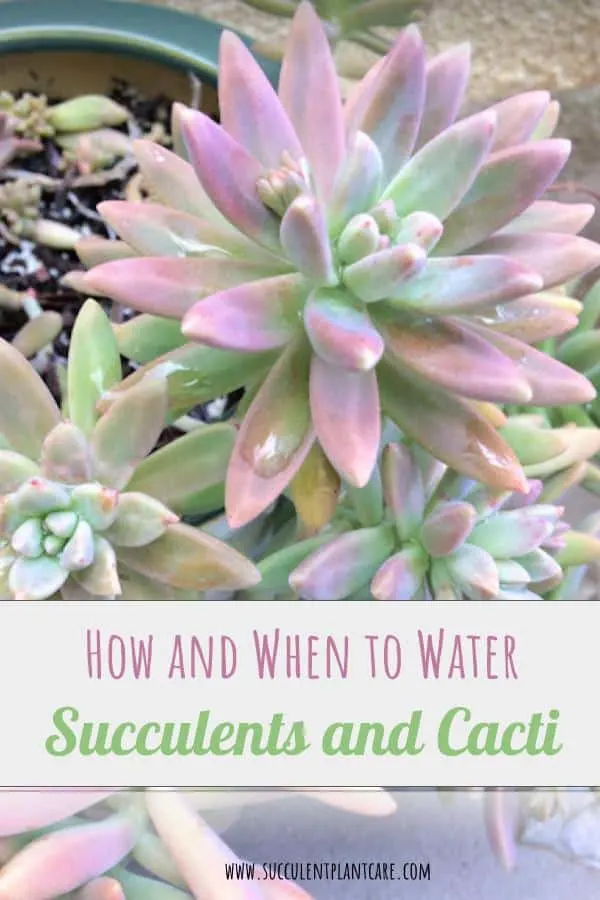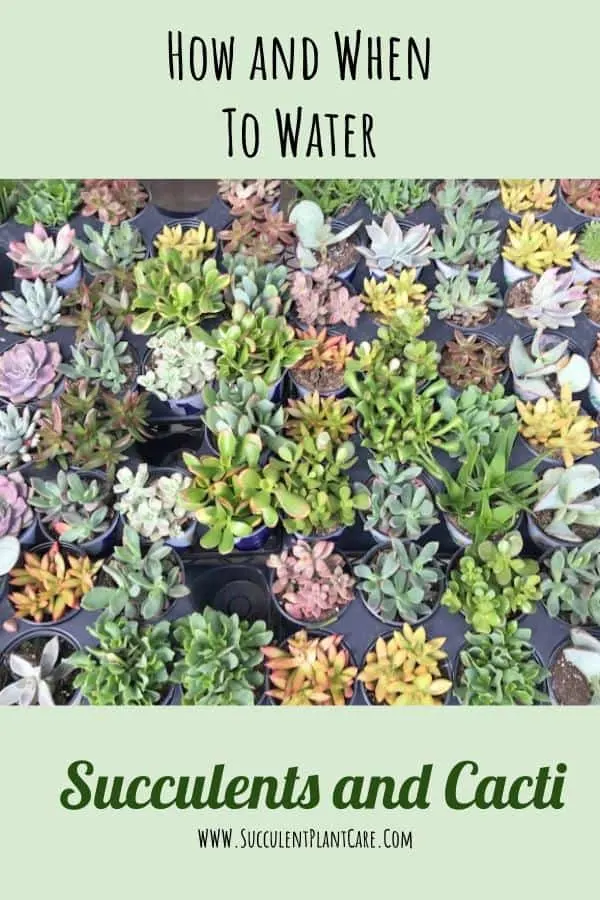Watering Cacti and Succulents
Watering is one of the most important aspects of succulent care. Knowing when and how to water your succulents are keys to their survival.
Overwatering is one of the easiest ways to accidentally kill your succulents due to their susceptibility to root rot, which is caused by damp roots. It is also dangerous to leave the plant completely dry for long periods of time, as the roots will start to die back.

How often do you need to water succulents indoors and outdoors?
The best way to determine when to water is to check the soil for moisture. Watering is only necessary when the soil is completely dry. Unlike other plants that need to stay moist, succulents’ soil should only be soaked temporarily when you water them and cannot stay moist for a long time. They also do not like to sit in wet soil for too long as this can promote root rot.
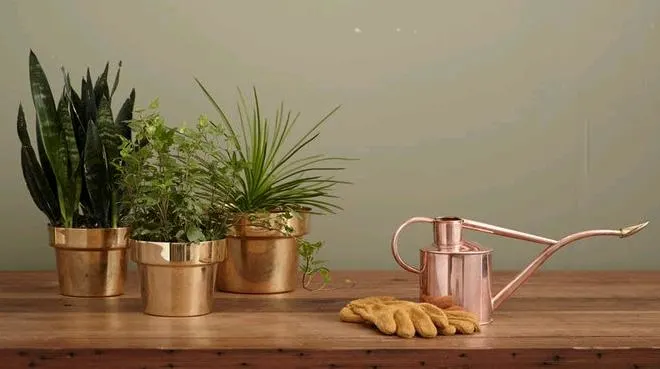
How often do you need to water indoor succulents?
One of the most dangerous things for your indoor succulents is watering them incorrectly. Succulents hold moisture in their leaves, stems and tissues. They use these stored water to survive in dry conditions. Too much water is deadly to these plants. But they still need to be watered in order to survive and thrive. Leaving them too dry for too long can also cause their roots to die. The best way to determine when to water is to examine the soil and feel for moisture. Do not just touch the surface of the soil, but the top inch of the soil needs to be dry to the touch before you water your plant.
How much and when you water also depends on the season. During the growing season, usually from spring to fall when growth is most active, water the plants thoroughly until some of the water begins to drain out of the holes of the pot (this may not happen with all potted pots). Sometimes, the water does not drain out of the pot but as long as you gave it a good drink of water, it should be fine. Make sure not to let the water collect in saucers. Pour out those excess water that collected in saucers. Allowing the water to drain out is good for the plants as it helps prevent root rot and it also prevents dissolved salts from accumulating in the soil. For most indoor potted plants, watering about once every ten to fourteen days during the active growing season should be sufficient.
During the inactive season (usually in winter time for most succulents), when the plant is dormant, water less frequently and less thoroughly. Check the soil for moisture and water only when the plant is dry to the touch but not completely bone-dry. Water only to moisten but not soak the plant. During the inactive months, the general rule is to water about once every three to four weeks. Pay attention to how your plants look. If they start looking shriveled between waterings, you may need to water them more often. If unsure in the beginning, water the plants lightly. It is better to under water than to over water until you figure out the ideal watering needs of your plants.
How often do you need to water outdoor succulents?
Outdoor succulents have slightly different watering needs as indoor plants because they are exposed to different conditions outdoors. During the active growing season, as a general rule, plants need to be watered every seven to ten days. Feel the soil for moisture. The top inch of the soil needs to be dry to the touch before watering. Water the plants thoroughly until some of the excess water seep out of the holes. Depending on your pot type and soil, excess water may not always drain out of the pot. As long as you watered thoroughly, it should be sufficient.
During the inactive season, water less often and more lightly, about every three to four weeks. The plant needs to be dry to the touch but not completely bone-dry. Watch your plants to see if they start showing signs of needing to be watered. When the leaves start shriveling and when they feel flat to the touch and not plump, it is time to water your plants.
Early morning is ideally the best time to water, especially for outdoor plants. This allows the plant to dry out during the heat of the day. Watering early in the morning allows the water to reach the bottom of the plants all the way to the roots and ensures your plant is well hydrated to better deal with the afternoon heat. Watering in the morning also prevents the leaves of your plants from being sunburned by allowing the plants to dry out before the more intense afternoon sun hits the plants.
Watering succulents in pots and containers without drainage holes
Some people advise against using containers without drainage holes for succulents. The reason being is that succulents do not like to sit in water. Having drainage holes allows excess water to drain out of the pots preventing root rot. You might be tempted to use a container without drainage holes because you like how it looks or you need to use it for a particular project. Whatever the reason, a container without any drainage holes is possible to use, but watering will be extra tricky because there is more possibility of overwatering and drowning your plants.
If you have containers without drainage holes in them, you need to pay extra care and attention when watering your succulents. Allow plants to dry out in between waterings and feel the soil for moisture. The top inch of the soil needs to feel dry to the touch before you water. Remember that excess water cannot drain out of the holes so go easy on watering. Using a syringe, a spray bottle, or squeeze bottle will help control the amount of water you put into the containers. When using a spray bottle, make sure to spray the soil or medium instead of just the top of the plant. You want the water to get to the roots where it is absorbed by the plant and not just mist the plant from the surface.
Watering frequency also depends on the growing season and size of your container. During the dry season or growing season, plants need more water. During the inactive growing season or when it’s cooler, water less frequently. The size of your container also determines how often and how much to water. Smaller containers hold less moisture than larger containers.
If unsure in the beginning, water the plants lightly and adjust as needed. It is better to under water than to over water until you get the hang of watering your plants in containers without drainage holes. If you accidentally pour too much water, you can get rid of the excess moisture by using a dry towel to dab the water. You can also pour excess water out carefully. Watering should be monitored closely when using these types of pots.
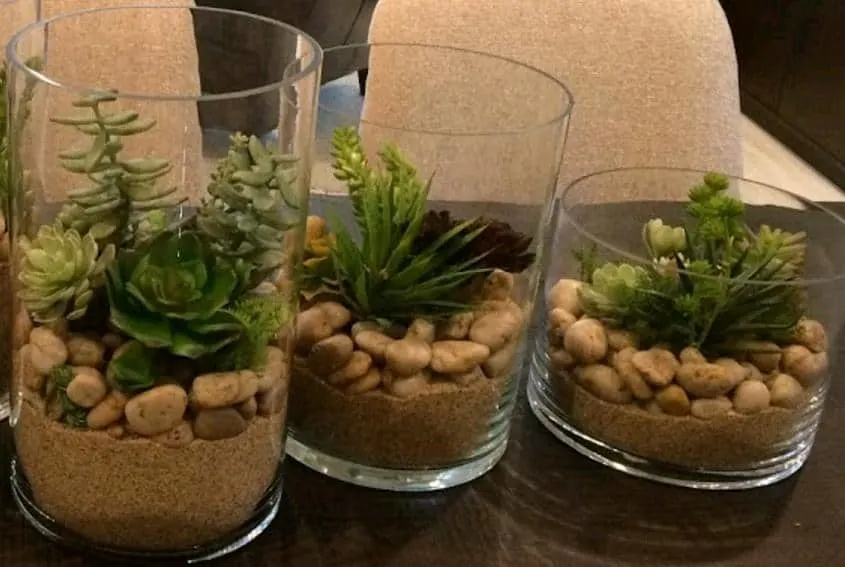
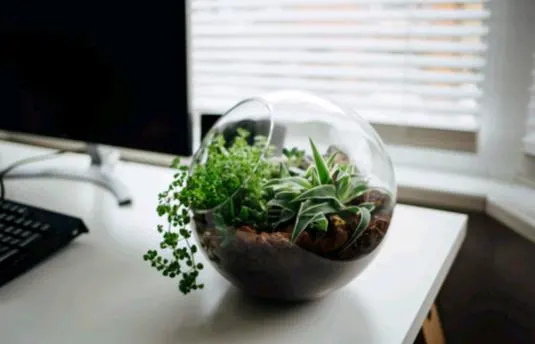
How to water a cactus– Does it differ from succulents’ watering needs?
Do cacti have different watering needs than succulents? When you think of cacti you think of dry, desert plants. Watering needs depend on many factors such as the growing season, whether they are outdoors or indoors, the type of containers or pots they are in, and more. Generally speaking, cacti and succulents have similar watering needs. During the active growing season, around spring to fall, cacti need to be watered about once a week. Give the plant a good soaking until water drains out of the hole of the pot. Be careful not to let the plant sit in water. Allow for excess water to drain out completely. If placed on a saucer, pour out excess water that may have dripped into the saucer. Before watering, check the soil for moisture. The top inch of the soil needs to feel dry before watering.
During the inactive growing season, slow down watering to about once a month. Do not soak cacti but give just enough water to provide moisture. Check the soil for moisture in between waterings. Make sure the top inch of the soil feels dry. Pay attention to how your plants look. If the plant starts showing signs of stress such as shriveling, you need to water it more. Water from the surface of the soil and not the top of the plant to prevent damaging the tissue of the cactus. Cacti exposed to too much moisture may suffer from stem or tissue damage by rotting or mold.
Watering succulents in the ground
Succulents are also grown in the ground. Succulent plants add beauty and dimension to outdoor landscapes. Certain succulent species thrive in-ground and make excellent ground cover. Watering requirements for succulents in ground depend on several factors such as the growing season, temperature and climate, area space and plant types. More importantly, choosing a well-draining soil is essential when planting succulents in-ground. Providing in-ground succulents with proper soil conditions go hand-in-hand with proper watering techniques.
Given the right medium, watering needs for succulents in-ground should vary according to the season. During the active growing season, around spring to fall, succulents need to be watered about once a week. They may need to be watered more during a heatwave or under intense heat. Feel the soil for moisture. The top inch of the soil needs to be dry to the touch before watering. Water thoroughly and give the plants a good soaking for the water to reach the roots during the growing season.
Water less frequently and more lightly during the dormant season. Water about once a month when the plant is not actively growing. Adjust watering as needed. If the plants show signs of stress from under watering, such as shriveling leaves, you need to water them more. Feel the soil for moisture before watering. The top inch of the soil needs to feel dry before watering again.
Early morning is ideally the best time to water in ground succulents. This allows the water to reach the plants’ roots and hydrate the plants to better deal with the afternoon heat. Watering in the morning also prevents the leaves of your plants from being sunburned by allowing the plants to dry out before the more intense afternoon sun hits the plants.
Moisture meters
Checking the soil for moisture is the best way to determine when to water your succulents. You can do this by feeling the soil with your fingertips, or you can use a moisture meter to be more precise. Moisture meters are handy gadgets that measure the humidity of the soil. They are useful tools to help prevent over or under watering your plants. There are many different types of moisture meters to choose from. Some are battery operated, some do not require batteries. They can be an invaluable tool to have, especially if you are unsure of how much and how often to water your succulents or if you have succulents in arrangements without drainage holes.
Humidity–how humid does it need to be for succulents and cacti?
Succulents and cacti differ from other houseplants in their humidity requirements. Due to their nature, succulents and cacti require less water and humidity to survive. They have water storing properties that help them withstand dry conditions that other houseplants cannot tolerate. Majority of houseplants thrive in a home environment of about 40-60% humidity. Cacti and succulents thrive in environments of around 10-30% humidity. Conditions in the home especially during the winter months when indoor heating is running, can be extra drying for most plants. If you find your home too dry even for your succulents and cacti, a quick remedy is to place a tray of water near your plants. The water evaporates and provides the needed humidity in the air.
Humidifier or dehumidifier
Another way to correct the humidity is by using a humidifier or a dehumidifier. A humidifier is a device that keeps the atmosphere in the room moist. A dehumidifier is a device that removes excess moisture in the air.
Hygrometer
Using a hygrometer is another way to determine the humidity in a room. A hygrometer is an instrument to measure the humidity in the air. It is an easy and inexpensive tool to use.
Some exceptions
Tropical succulents and jungle cacti are a group of cacti that grow in the rainforests. These include species such as Schlumbergera, Rhipsalis, Acanthocereus, Lepismium, and many more. These plants differ from other cacti species due to their higher humidity needs and inability to withstand harsh and very dry conditions of the desert.
These plants require proper well-draining soil. Even though they are accustomed to a more humid environment, over watering is proven to be detrimental to these plants. The easiest way to tell when to water is to feel the soil for moisture. The top ½ inch of the soil needs to be dry before watering. If the soil feels moist, do not water the plant. Over watering can cause the plant to rot and be more susceptible to fungal diseases.
Jungle cacti and tropical succulents will not tolerate intense heat or frost. Unlike other succulents, these plants can not go too long without water. When caring for these plants, do not let them go too long without water. They differ from other succulents and cacti by their inability to withstand drought and intense heat. When the leaves and stem segments show signs of under water stress, such as shriveling, and the soil feels dry, it is time to water.
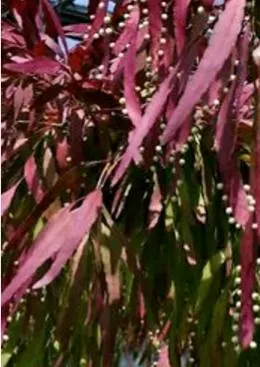
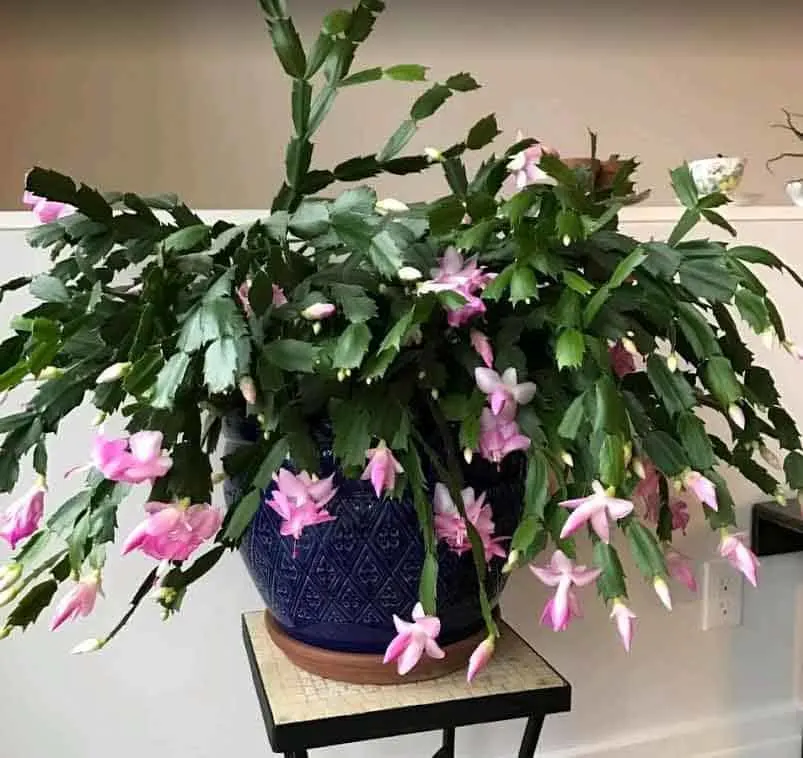
Soft water vs. hard water for succulents
Water hardness is determined by the concentration of ions in the water. Soft water is water that has been treated with sodium or potassium to remove minerals such as calcium and magnesium. Soft water normally contains elevated levels of sodium. Rainwater as it falls is naturally soft water. Hard water is water that contains high concentrations of dissolved minerals such as calcium and magnesium.
Hard Water
Hard water can leave mineral build up in the plants when used over time due to its high concentrations of dissolved minerals. Mineral build-up can leave its mark on your succulents. Getting rid of water stains on your plants by repotting your plants periodically can help with this problem.
Soft Water
Soft water contains high concentrations of sodium which can be harmful to your plants. The sodium in the water can build up in the soil and prevent growth. High concentrations of salt can harm your plants overtime as it interferes with proper hydration and absorption of water.
Rainwater
Rainwater is the preferred water for succulents as they contain the right amount of minerals for your plants to thrive. Whenever possible, try to collect rainwater and store it for later use on your plants.
Diluting your water with distilled water or rain water can help minimize build-up of salts and other deposits. Keep in mind that salt and other minerals will still build up overtime and need to be dealt with periodically.
How to remove mineral deposits from your succulents
You can remove water stains or mineral build-up on your plants naturally and easily.
Ingredients:
White vinegar (1 Tablespoon)
Distilled water or rain water (1 quart)
Mix the vinegar and water in a container. Use a cotton ball, Q-tip, or washcloth to dip in the solution. Gently wipe any visible water stains or mineral build-up on the leaves or anywhere on the plant. You can use the same solution to clean water stains from pots and containers.
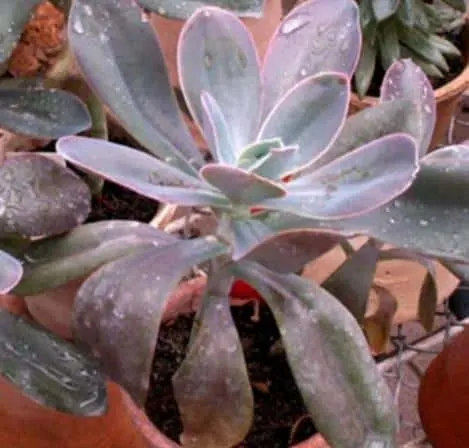
How to avoid overwatering and underwatering your succulents
Underwatered succulents
Underwatering your succulents may not be as deadly as overwatering them, but constantly underwatering your succulents is also detrimental to the plants, especially during warmer months or growing season. They do need to be watered, and watered properly, to thrive and grow. You can tell if your plants are underwatered when they start showing these signs:
Shriveling or puckering of leaves
Succulents are known for their plump and fleshy leaves. The plant will start to shrivel and pucker, often from the lower leaves first. As the plant uses up all its stored water from the tissues, the shriveling will spread to the top of the plant. They will also look dehydrated and feel dry.
Leaves feel flat
Succulents that are underwatered have flattened, soft leaves. You can feel the leaves and squeeze them. If the leaves feel flat, soft and dry, then they are literally dehydrated and need more water.
Discoloring
Underwatered plants may also start changing colors. They may darken or begin to yellow. Along with shriveled leaves and discoloration, these are tell-tale signs that it is time to water your plants or to increase frequency and amount of watering.
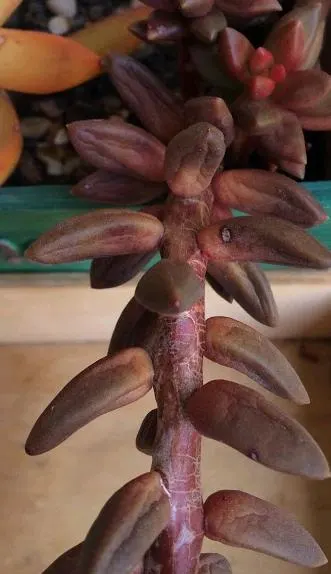
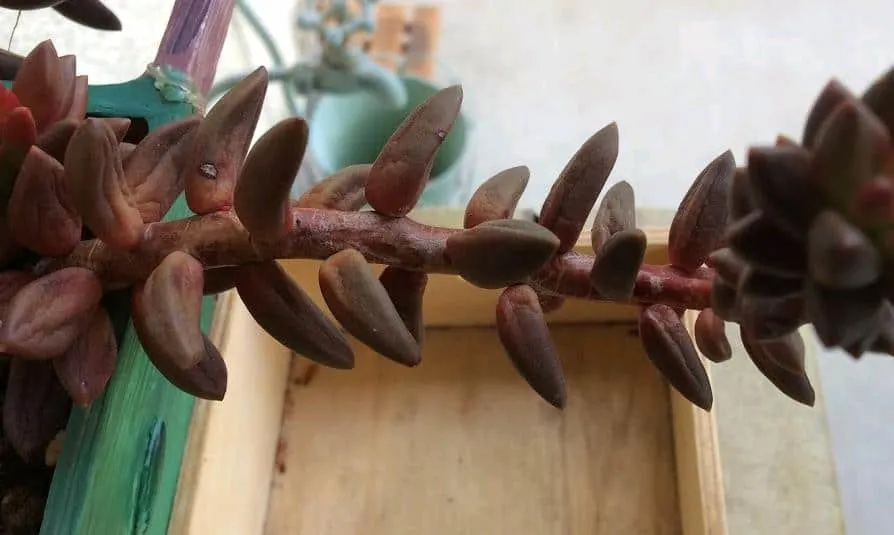
These are pictures of underwatered succulents. You can see the shriveled, puckered leaves. These plants have not been watered for a while and are in need of watering.
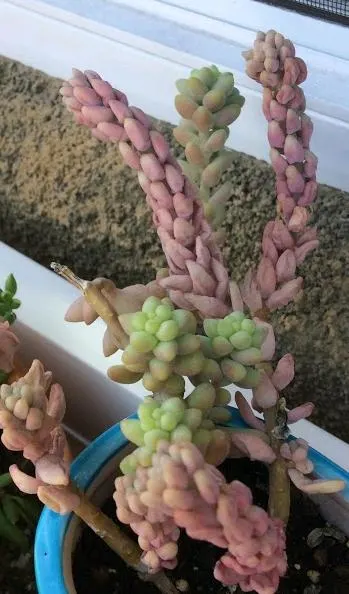
Overwatered succulents
Overwatering succulents is one of the quickest ways to accidentally kill them. It can be tricky to tell if your plants are overwatered because they may show similar signs as those of underwatered plants. They key is to pay close attention to watering techniques and other signs. Overwatered succulents show these signs:
Wilting and shriveling
Overwatered plants look wilted and also shrivel, which may confuse others into thinking they need more water. Usually if the plants look green, the soil is wet, and you know your plant is well-watered, then you are overwatering and not underwatering your plants.
Leaves feel plump
Feel the leaves to see if they are flat or firm. If you see shriveling but the leaves still feel plump and hard, then the plant is most likely getting too much water.
Brown or yellow leaves
When the leaves start turning brown or yellow, it is often a sign that something is wrong with the plant. If you notice the leaves of your plants turning brown and yellow, along with wilting and falling leaves, these are often signs that you need to adjust your watering frequecny. If you know your plants are well-watered, they might actually be getting too much water.
Mushy plants
Another sign of overwatering is when your plant starts becoming mushy from too much water. The plants have literally absorbed too much water and cannot take in anymore. They blow up and burst and turn into mush.
Root rot
Succulents are susceptible to root rot. Root rot occurs when the plant is constantly exposed to too much moisture and the roots begin to decay. Fungal disease sets in and cause the plant to wilt and die. You may notice your plant dropping all of its leaves and looking unwell. If you suspect root rot, remove the plant from the pot and soil and inspect the roots. If the roots appear mushy or slimy and grey or black, root rot may have set in from overwatering.
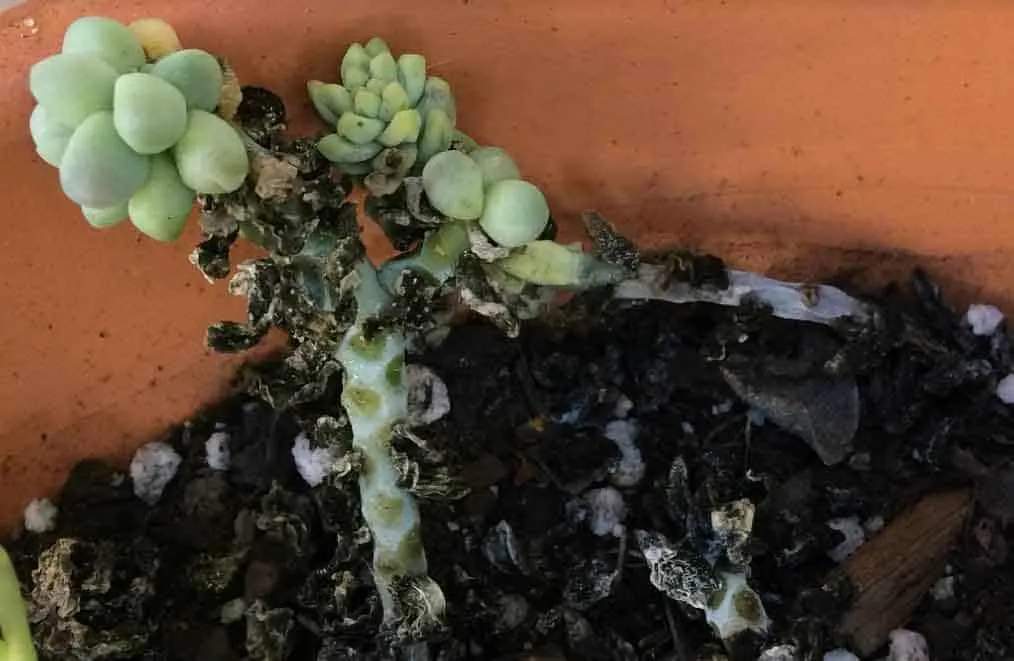
These plants have been overwatered and are suffering from mold and rot. They have dropped most of their leaves. Their leaves were mushy.
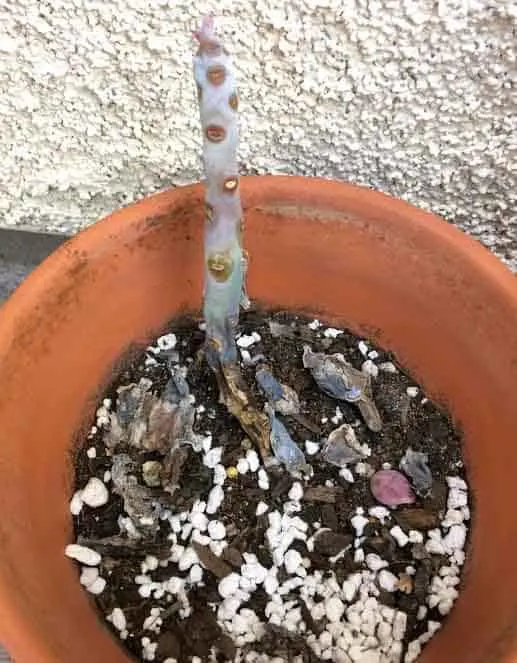
Avoid overwatering and underwatering by paying close attention to your plants. A good rule of thumb is to check the soil for moisture. Do not water until the soil feels dry to touch about an inch from the top. Succulents need more water in the spring or when it’s actively growing, about every 7-10 days. When they are not growing, or during dormant periods, water less frequently, about once a month. Other factors need to be considered when determining watering frequency such as humidity, temperature, the amount of light and the size of containers.
You can also lift the pot of the plant to feel how heavy it is. A well-hydrated plant will have a heavier pot. Dry plants feel lighter and are easier to lift.
When changing watering schedule, make gradual changes. Do not make drastic changes as this can stress the plant. If your plants are being watered once a week and you need to decrease watering, do not go from once a week to once a month. Try to decrease gradually to minimize stress to the plant.
If you are wondering where you can purchase succulents and cacti online, please check out my Resource Page to get some ideas.
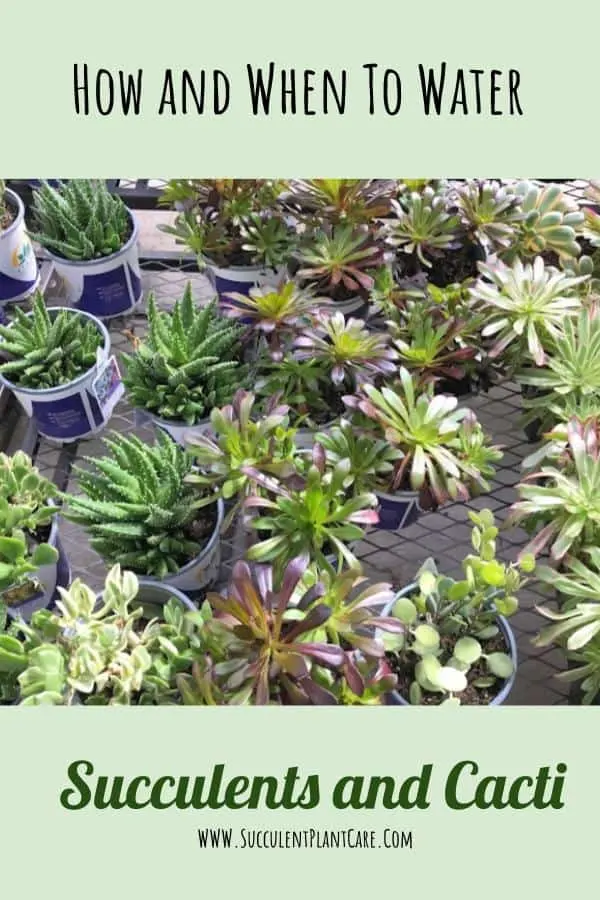
Pin this to save for later or share with others now!
